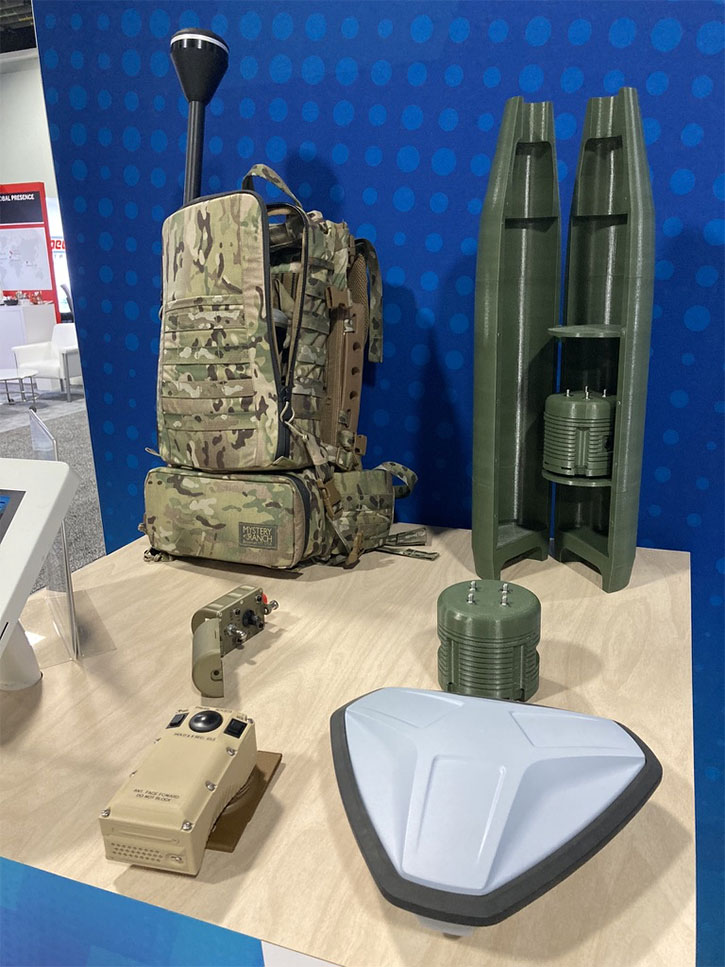
Low-cost jammers are widely accessible and offer a basic but effective means of disrupting GNSS signals. Drivers who want to prevent their bosses from constantly tracking delivery trucks use such devices. They emit radio frequency (RF) noise or signals on the same frequencies used by GNSS satellites, overwhelming the receiver’s ability to discern the legitimate satellite signal. Their affordability and simplicity make them a common choice for non-state actors and less technologically advanced militaries.
In a counter-UAS role, GPS denial often uses broadband jamming and datalink disruption as part of a comprehensive EW capability. The Australia-based DroneShield company, one of the pioneers in this field, has recently announced the introduction of GNSS disruption targeted to a specific area.
Military users often opt for dedicated EW assets to engage radio-electronic signals at the GNSS frequencies (lower and upper L bands). Some systems employ signal generators to defeat specific threats, such as drones and GPS-guided weapons, while others disrupt GNSS signals, creating a ‘defensive bubble’ around important assets and targets, thus reducing the probability of successful attack by guided weapons. Some of these systems are mounted on vehicles, enabling the relocation of assets, while others are fixed in specific positions. A typical relocatable system that blocks GNSS signals at longer distances is the Russian R30Zh Zhitel, which can jam satellite and cellular phone communications from 100 MHz to 2,000 MHz frequency bands, covering all GNSS frequencies. Zhitel has an effective radius of 25 km against cellular phones and longer against GNSS.

Denial of GNSS signals over a wide area requires a more powerful or distributed array of emitters. Two Russian systems are known to be capable of delivering GNSS jamming over a large area. The Pole 21E system consists of jammers placed on cell towers. Multiple elements of this type can be integrated into a jammer network, denying GNSS signal over large areas. The system uses the communications mast’s power and GSM communications as a backup. The Ukrainians have repeatedly attacked cell towers along the front lines to destroy such systems and open the sky for drone activity.

Another powerful Russian counter-GNSS effort is the 14Ts227 Tobol, a system designed to disrupt GNSS signals over a large area, thus denying navigation signals from attack drones and cruise missiles. Ten such systems are employed across Russian territory, one of which is in Kaliningrad. These powerful systems suppress GPS coverage in the Baltic, Scandinavia, and Eastern Europe. While the Tobol was reportedly the cause of GNSS disruptions across Europe, the Ukrainians repeatedly conducted precision drone attacks inside Russia, demonstrating their ability to operate in GNSS-contested airspace.
In 2021, the Turkish defense industry organization and Meteksan teamed to develop the Seymen, a sophisticated, mobile NAVWAR EW system unveiled as a scaled model at the IDEF exhibition. The system will enable selective jamming and deception of GNSS signals affecting targeted systems while enabling friendly forces to operate without signal degradation. The system can engage multiple targets in different directions and across several GNSS constellations. Seymen can operate independently or in coordination with multiple emitters as part of a system.

The key for operating systems such as Symen is using active electronic steered antennae (AESA) for a more discrete approach. An example of such a system is SRC’s steerable electronic attack phases array (SEAPA), a prototype system that employs precision electronic targeting and engagement for congested environments. SEAPA covers the L band and the entire GNSS frequency band and can deliver surgical PNT disruption for air and missile defense, counter UAS, and critical infrastructure defense. This RF solution can precisely target and disrupt hostile systems while ensuring friendly systems’ safety and continued operation in the same airspace and across the electromagnetic spectrum. SEAPA uses configurable beamforming to steer the electronic jamming beams in azimuth and elevation, allowing the system to track targets in flight. Beams can be narrowed to 20 deg for precision effects or widened to 60 deg to engage swarms. Using variable power beams, it can simultaneously engage targets at both short and long-range. Unlike omnidirectional systems, SEAPA provides advanced NAVWAR capabilities while minimizing unintended impact on non-targeted systems.

A different selective GNSS denial can be employed tactically, localized using drone-based effectors or artillery-deployed jammers, enabling forces to project electronic warfare capabilities deep into enemy territory. Two examples from SRC are the Silent Cyclone from SRC, a backpacked EW system, and the Silent Impact, a puck-like device packable into 155mm artillery rounds and fired at the enemy’s rear area. These systems can deliver cyber electromagnetic attack (CEMA) payloads in flight, using parachutes to stay aloft for an extended period. The jammers are built to survive the ground impact and continue their jamming on the ground.
This deployment method allows for targeted jamming in specific areas near headquarters, forward landing strips, or choke points where no navigation could cause many disruptions. Using low-power localized effects can potentially blind and disorient enemy forces without widespread disruption that might affect friendly forces.



















